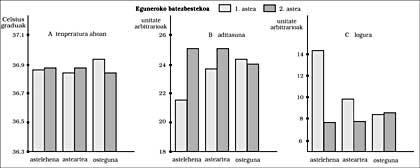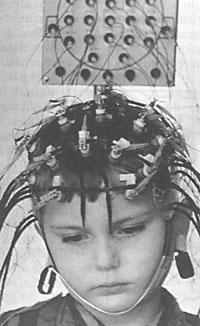Winter time, summer: what for health?
1991/06/01 Agirre, Jabier - Medikua eta OEEko kidea Iturria: Elhuyar aldizkaria
Much has been spoken and written about the change of time, but do we have any clear idea about the subject? It is not my intention to act here in favor of or against that change of time, but to argue for what serves to lengthen the duration of the day in summer and to make known the experiments that have been carried out recently with schoolchildren to show that there is no harm to our health.
As I mentioned in other works (see Chronobiology: Is the body a clock? ... Elhuyar. Science and Technology. Number 46. April 1991), rhythmicity is one of the fundamental characteristics of living matter and the periodic changes of twenty-four hours (which constitute the circadian rhythm) are those who govern the functions or functions of all living beings, from eukaryotic uniciellular to man. With few exceptions, all our metabolic, physiological and psychological activities are rhythmic.

Muscle strength, body temperature, mental performance, neuroendocrine secretions (to mention just a few), have a maximum point in twenty hours (called acrophase) and a minimum. These summits and depressions are not separated in any form or randomly on a 24h scale. On the contrary, they respond to a certain temporal structure. Thus, CHRONOBIOLOGY is defined as the study of the temporal structure of organisms, analyzing their biological rhythms, alterations and mechanisms.
Currently, the existence of circadian biological watches (that is, with a cycle of about 24 hours) is proven. They are self-rhythmic systems capable of performing a time control function. In the human being the biological watches are fine-tuned and calibrated for 24h. They are related to our daily life through the couple of activities/breaks, or what is the same, of the bus/work/bed program.
Adjustment of biological rhythms
Through its biological rhythms and thanks to the synchronization of these rhythms, man (like other animal and vegetable species) is able to adapt to the environment, taking into account that the changes in this environment are intimately related to the tour that the Earth realizes every twenty hours around its axis. Our programming allows, for example, that during sleep the levels of adrenaline and cortisol rise up, so that they are at the best level when it comes to awakening.
Waste work (night, with very irregular shifts) or transmeridian flights (from Paris to New York, p. (ex.) leave the body almost in experimental state, the synchronizers are outdated for five or more hours. This displacement of the time of rest and of sight (of exercise) obliges the body to put again to a point his biological clocks to place the acrophases in their proper place to a scale of twenty hours of rhythm.
The organism does not adjust abruptly to the new schedule, since the mechanisms to readjust are complex biological processes. Of course, it is much easier to perform mechanical and/or electronic adjustment, such as putting the clock at the right time.

Variables such as sleep/rhythm watching are immediately adjusted in two or five days. Others, on the contrary, need more time to achieve this adjustment: between five and fifteen days to adjust the activity of the adrenal skin. This will cause an alteration of the temporary organization that, depending on each physiological variable, will be accentuated to a greater or lesser extent in a person. In phase delay (prolongation of the look, as happens with the flight from Paris to New York, for example), almost 85% of people have a pretty fast fit. On the contrary, when the gaze is shortened, as in the New York-Paris flight, the adjustment of biological rhythms is much slower.
The time slipping of the synchronizers should be at least 5 hours to cause the change of circadian rhythms. The greater this displacement (the limit is between 7 and 12 hours), the longer the adjustment duration. Important time shifts (as in the night work, of five or more hours) can cause a number of alterations in some people: permanent fatigue (which does not disappear at rest), alterations of sleep (difficulty sleeping, awakening with dove, poor quality breaks), irritability (unjustified anger, discussions with friends) and digestive alterations.
At the other end, one-hour or 2-hour slides do not significantly affect people's temporary organization. This means that in these cases no alteration of biological rhythms, no clinical effects or symptoms is detected. It seems that the human body is able to withstand without problems an hour of change.
95 girls in the Paris area (all of them students from a school) were studied in a study between March 30 and April 11, 1987, due to the change of time that took place on March 29 at 12 pm. Girls from 8 to 11 years, 3rd EGB, Daily activity lasted from 7.30 to 9.00 hours. At certain hours (9 h, 11 h, 14 h and 16 h) the girls themselves, who devoted themselves voluntarily to this research, measured various psychophysiological variables (fatigue, sleep, intelligence) by analog visual scales, besides measuring their oral temperature. These measurements were performed on Mondays, Tuesdays and Thursdays for two consecutive weeks. (See results in the image).
The measurements made in students aged 10-11 years are presented below: A, mouth temperature; B, age; C, sleep. The temperature does not suffer any statistically significant incident. Despite the fact that the following Monday to the change of hours is more accentuated the decrease of age and the increase of sleep, the situation is normalized for Thursday.
Why so much scandal?
There are, therefore, no biological and/or clinical reasons to affirm that the one-hour phase is a factor that can alter our physical and mental health or that of our children. Let us also say that in the two works dedicated to the chronobiology of the child, recently published, the effects of the change of time are not mentioned. To finish we will repeat what the saying says: Fourteen distant nuts, four close.

Gai honi buruzko eduki gehiago
Elhuyarrek garatutako teknologia






